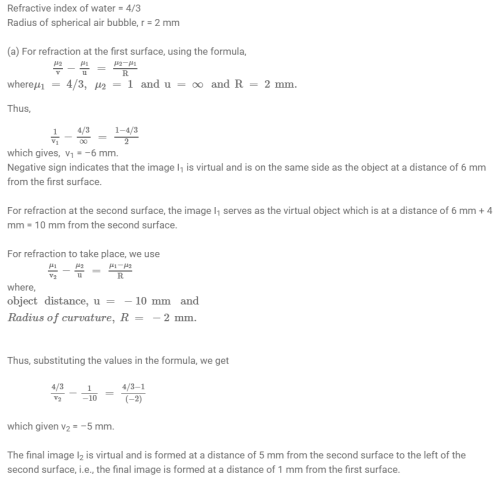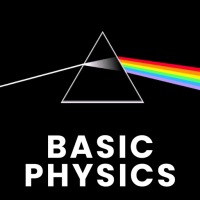Physics Exam > Physics Questions > A parallel beam of light travelling in water ...
Start Learning for Free
A parallel beam of light travelling in water (refractive index = 4/3) is refracted by a spherical air bubble of radius 2mm situated in water. Assuming the light rays to be parallel, find the position of the final image ?
- a)5 mm
- b)6 mm
- c)– 6 mm
- d)– 5 mm
Correct answer is option 'D'. Can you explain this answer?
Most Upvoted Answer
A parallel beam of light travelling in water (refractive index = 4/3) ...

Free Test
FREE
| Start Free Test |
Community Answer
A parallel beam of light travelling in water (refractive index = 4/3) ...
To solve this problem, we can use the concept of refraction at a spherical surface. The key idea is that light rays passing through a medium with a higher refractive index will bend towards the normal, while light rays passing through a medium with a lower refractive index will bend away from the normal.
Given:
- Refractive index of water, n1 = 4/3
- Radius of the air bubble, r = 2 mm
We need to find the position of the final image formed by the refracted light rays.
1. Calculate the angle of refraction:
We can use Snell's law to calculate the angle of refraction.
n1 * sin(angle of incidence) = n2 * sin(angle of refraction)
Since the light rays are parallel, the angle of incidence is 0 degrees.
Therefore, sin(angle of refraction) = 0.
This implies that the angle of refraction is also 0 degrees.
2. Calculate the angle of deviation:
The angle of deviation can be calculated using the formula:
Angle of deviation = 2 * (angle of refraction - angle of incidence)
Since the angle of incidence is 0 degrees and the angle of refraction is also 0 degrees, the angle of deviation is 0 degrees.
3. Calculate the position of the final image:
The position of the final image can be calculated using the formula:
Position of the final image = (2 * r) * tan(angle of deviation/2)
Substituting the values, we get:
Position of the final image = (2 * 2 mm) * tan(0/2)
Position of the final image = 0 mm
Therefore, the position of the final image is 0 mm.
However, it is important to note that in this case, since the angle of refraction is 0 degrees, the light rays passing through the air bubble do not deviate from their original path. Hence, the final image is formed at the same position as the original object, which is 0 mm.
Given:
- Refractive index of water, n1 = 4/3
- Radius of the air bubble, r = 2 mm
We need to find the position of the final image formed by the refracted light rays.
1. Calculate the angle of refraction:
We can use Snell's law to calculate the angle of refraction.
n1 * sin(angle of incidence) = n2 * sin(angle of refraction)
Since the light rays are parallel, the angle of incidence is 0 degrees.
Therefore, sin(angle of refraction) = 0.
This implies that the angle of refraction is also 0 degrees.
2. Calculate the angle of deviation:
The angle of deviation can be calculated using the formula:
Angle of deviation = 2 * (angle of refraction - angle of incidence)
Since the angle of incidence is 0 degrees and the angle of refraction is also 0 degrees, the angle of deviation is 0 degrees.
3. Calculate the position of the final image:
The position of the final image can be calculated using the formula:
Position of the final image = (2 * r) * tan(angle of deviation/2)
Substituting the values, we get:
Position of the final image = (2 * 2 mm) * tan(0/2)
Position of the final image = 0 mm
Therefore, the position of the final image is 0 mm.
However, it is important to note that in this case, since the angle of refraction is 0 degrees, the light rays passing through the air bubble do not deviate from their original path. Hence, the final image is formed at the same position as the original object, which is 0 mm.

|
Explore Courses for Physics exam
|

|
Question Description
A parallel beam of light travelling in water (refractive index = 4/3) is refracted by a spherical air bubble of radius 2mm situated in water. Assuming the light rays to be parallel, find the position of the final image ?a)5 mmb)6 mmc)– 6 mmd)– 5 mmCorrect answer is option 'D'. Can you explain this answer? for Physics 2025 is part of Physics preparation. The Question and answers have been prepared according to the Physics exam syllabus. Information about A parallel beam of light travelling in water (refractive index = 4/3) is refracted by a spherical air bubble of radius 2mm situated in water. Assuming the light rays to be parallel, find the position of the final image ?a)5 mmb)6 mmc)– 6 mmd)– 5 mmCorrect answer is option 'D'. Can you explain this answer? covers all topics & solutions for Physics 2025 Exam. Find important definitions, questions, meanings, examples, exercises and tests below for A parallel beam of light travelling in water (refractive index = 4/3) is refracted by a spherical air bubble of radius 2mm situated in water. Assuming the light rays to be parallel, find the position of the final image ?a)5 mmb)6 mmc)– 6 mmd)– 5 mmCorrect answer is option 'D'. Can you explain this answer?.
A parallel beam of light travelling in water (refractive index = 4/3) is refracted by a spherical air bubble of radius 2mm situated in water. Assuming the light rays to be parallel, find the position of the final image ?a)5 mmb)6 mmc)– 6 mmd)– 5 mmCorrect answer is option 'D'. Can you explain this answer? for Physics 2025 is part of Physics preparation. The Question and answers have been prepared according to the Physics exam syllabus. Information about A parallel beam of light travelling in water (refractive index = 4/3) is refracted by a spherical air bubble of radius 2mm situated in water. Assuming the light rays to be parallel, find the position of the final image ?a)5 mmb)6 mmc)– 6 mmd)– 5 mmCorrect answer is option 'D'. Can you explain this answer? covers all topics & solutions for Physics 2025 Exam. Find important definitions, questions, meanings, examples, exercises and tests below for A parallel beam of light travelling in water (refractive index = 4/3) is refracted by a spherical air bubble of radius 2mm situated in water. Assuming the light rays to be parallel, find the position of the final image ?a)5 mmb)6 mmc)– 6 mmd)– 5 mmCorrect answer is option 'D'. Can you explain this answer?.
Solutions for A parallel beam of light travelling in water (refractive index = 4/3) is refracted by a spherical air bubble of radius 2mm situated in water. Assuming the light rays to be parallel, find the position of the final image ?a)5 mmb)6 mmc)– 6 mmd)– 5 mmCorrect answer is option 'D'. Can you explain this answer? in English & in Hindi are available as part of our courses for Physics.
Download more important topics, notes, lectures and mock test series for Physics Exam by signing up for free.
Here you can find the meaning of A parallel beam of light travelling in water (refractive index = 4/3) is refracted by a spherical air bubble of radius 2mm situated in water. Assuming the light rays to be parallel, find the position of the final image ?a)5 mmb)6 mmc)– 6 mmd)– 5 mmCorrect answer is option 'D'. Can you explain this answer? defined & explained in the simplest way possible. Besides giving the explanation of
A parallel beam of light travelling in water (refractive index = 4/3) is refracted by a spherical air bubble of radius 2mm situated in water. Assuming the light rays to be parallel, find the position of the final image ?a)5 mmb)6 mmc)– 6 mmd)– 5 mmCorrect answer is option 'D'. Can you explain this answer?, a detailed solution for A parallel beam of light travelling in water (refractive index = 4/3) is refracted by a spherical air bubble of radius 2mm situated in water. Assuming the light rays to be parallel, find the position of the final image ?a)5 mmb)6 mmc)– 6 mmd)– 5 mmCorrect answer is option 'D'. Can you explain this answer? has been provided alongside types of A parallel beam of light travelling in water (refractive index = 4/3) is refracted by a spherical air bubble of radius 2mm situated in water. Assuming the light rays to be parallel, find the position of the final image ?a)5 mmb)6 mmc)– 6 mmd)– 5 mmCorrect answer is option 'D'. Can you explain this answer? theory, EduRev gives you an
ample number of questions to practice A parallel beam of light travelling in water (refractive index = 4/3) is refracted by a spherical air bubble of radius 2mm situated in water. Assuming the light rays to be parallel, find the position of the final image ?a)5 mmb)6 mmc)– 6 mmd)– 5 mmCorrect answer is option 'D'. Can you explain this answer? tests, examples and also practice Physics tests.

|
Explore Courses for Physics exam
|

|
Signup for Free!
Signup to see your scores go up within 7 days! Learn & Practice with 1000+ FREE Notes, Videos & Tests.























